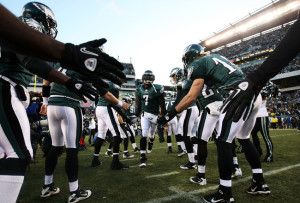 On March 12 the NFL will open the stage to its version of some high stakes bidding wars. The new 2013 League Year begins on March 12, and it marks the first day teams are free to begin signing free agents from other teams. Teams, players, agents, fans, and the media look forward to this day every year.
On March 12 the NFL will open the stage to its version of some high stakes bidding wars. The new 2013 League Year begins on March 12, and it marks the first day teams are free to begin signing free agents from other teams. Teams, players, agents, fans, and the media look forward to this day every year.
Know Your Own
Team executives on every team know the contract status of every player on its roster. They take note of players that have contracts expiring at the end of the season. They make it a point to re-sign their own players that they want to retain for future years before their contracts expire at the end of the League Year. A team can re-sign its own players to contract extensions at any time, but true crunch time is this last week before free agency opens (and the new League Year begins).
As the new League Year approaches, teams are given a period of 17 days to decide if they would like to use a Franchise Tag. Each team receives the ability to use ONE tag on ONE player each off-season during this specified period. These tags are utilized by teams to take one of their free agents off the market by assigning him a 1-year contract tender for an amount equivalent to the highest paid players at his position in the league. Once the player signs the tender, he is guaranteed that salary amount for the upcoming season. The calculations can be a bit complex, so for the sake of simplicity, just keep in mind that the salaries tied to these tags are HIGH! The decision to apply this tag indicates that a team must truly value the player as one of the best at the position, be willing to pay him accordingly and have the salary cap space to do so.
The Many Games of Tag
Just because a player has received a Franchise Tag does not mean he will be playing for the team in the upcoming season. A tag technically just removes a player from the open market. Teams often apply the tag just to prevent another team from signing him or to generate compensation.
However, a player is not limited to a 1-year deal with his current team in this situation. The player could sign a new multi-year contract with the original team thereby overriding the Franchise Tag. He could refuse to sign the tender and sit out the season without pay. Conversely, the team could offer the Franchise Tag with the sole intention of soliciting trade offers. If given a Non-Exclusive Franchise Tag, a team could be seeking the two first round draft choices it would receive as compensation if the player chooses to sign a multi-year offer sheet with another team. Or the team could place a Franchise Tag on a player as a method of telling the player that negotiations for a long term contract are not going well and the figures demanded are not realistic for the team. In this case, the team is essentially telling the player that they would rather pay him exorbitantly for one year than to agree to his demands for a long-term contract.
 Crucial Decisions
Crucial Decisions
As the start of free agency approaches, teams must decide which players to take off the market via re-signing and/or the application of the Franchise Tag. Numerous players have been re-signed for 2013 as March 12 approaches, and 8 players also received the pricey Franchise Tag designations. But what if there are potential free agents out there on other teams that a team likes more? Is it worth waiting to see if the team can become the most desired destination for a free agent on another team? Is it worth the risk of not re-signing one of its own players hoping that the free agent it desires will not re-sign with his current team prior to free agency opening? Even more worrisome, is it worth it for a team to gamble on the chance that its offer will be the best contract offer in the eyes of the free agent?
While it is important to decide which, if any, free agents to target on other teams, each team must also decide which of its own players to re-sign. There are a number of reasons a team may decide to not re-sign all of its own free agents, to include age, contract demands, character concerns, injury history, salary cap issues, and roster conditions. These are all good reasons, but the best rationale to not re-sign a player is because the team has a more than capable replacement already on its’ roster.
Subtle Talks
Teams typically can gauge the intentions and interest levels of free agents through player agents. Agents are technically not supposed to talk about free agent clients. But they are seeking to establish the market for their clients as much as teams want to gauge the number of teams interested and the expected price tag. In years past, the NFL has prohibited teams from inquiring about players on another team’s roster until free agency opened with the start of the new League Year. But beginning this year teams are being given a 3-day grace period prior to the start of free agency to hold these discussions. The NFL League Office realized that these prohibited preliminary talks occurred, and with no actual way to monitor and prevent the parties from talking, they figured that authorizing a 3-day period might help to curb violation of the rule in the days prior to the 3-day period.
Nevertheless, teams and agents still talk before this period: They not only talk at the NFL Combine, but they also talk in code throughout the season. A team can call an agent about other players that the agent represents, at which time they might also solicit a comment about a potential free agent. There are plenty of legitimate reasons to call agents during the season, to include wanting to bring in a player for a workout, inquiring about the status of a player that went unsigned, and most importantly, calling about a player on the team’s current roster. At that time a team could easily slip in a question like, “Do you think any top linebackers will be available in free agency?” The agent might respond with something like, “I think my guy might be looking to move on. His current team isn’t showing enough interest in re-signing him.” This conveniently sends the message that the two parties have some degree of mutual interest.
 A Winning Formula
A Winning Formula
The best teams have a Scouting department that excels at identifying college talent that will match the team’s position profiles. As the team selects these players in the NFL Draft each year, players that excel within the team’s schemes and philosophy are constantly being added to the roster. Therefore, a team can afford to let a high priced free agent leave instead of re-signing him to an expensive deal, because they know they have a cheaper and ‘unknown’ replacement ready and waiting. They can simply ‘reload.’
Teams with low coaching and management turnover maintain a level of continuity in schemes and philosophy, thereby allowing their players to excel within a consistent team model. With continued excellence comes repeated playoff berths and more team success. And more team success means everyone is happy: Management is thrilled with roster decisions, owners make money, coaches keep their jobs with salary raises, and players excel on the field. Hopefully this results in Super Bowl titles, but it also means its own players will desire bigger contracts. In this salary cap era, a team cannot afford to re-sign all of its own free agents, especially if player’s price tags have gone up due to consistent team success.
Conversely, teams that are not built correctly don’t win games, players become disgruntled and want to leave, coaches and management get fired, and no level of continuity is ever established. Losing breeds change and continuous change breeds losing. If a team keeps changing its coaches, systems, schemes and philosophy, it will also likely continue to change the players it views as ideal fits. Not only does this change the type of players targeted in the Draft every year, but it also never gives the roster a singular identity. Players are constantly shed to make room for new players that fit better, and the only way to address those immediate position needs is for the team to turn to free agency to try to fill the holes.
 All is Not as it Seems
All is Not as it Seems
Now you know that just because you saw a team out in free agency making all kinds of moves, it does not mean the team has had a great off-season. It is not an indicator that the team made the most out of free agency, and it does not mean that it will be some kind of “dream team.” It doesn’t even mean that the team will be successful in the upcoming season. In all actuality, the fact that a team was very active in signing other team’s free agents is usually an indication that the team’s roster was not very solid, so the team felt obligated to look to free agency to fill multiple holes. Therefore, it should come as no surprise that the most active teams in free agency rarely reap the rewards of post-season success, not to mention setting themselves up for a salary cap mess. Sure, there are occasional “diamonds in the rough” in free agency, but those cases are in the minority.
As free agency begins, any and all activity, rumors, and sightings will be closely monitored. But you can now ask the question: Is a team active in free agency because it is trying to go from Super Bowl runner-up to Super Bowl champ, or is it because the team believes it desperately needs to fill multiple holes? Remember, these are holes being filled with players that other teams chose to let go!
So will you be disappointed this year if your favorite team doesn’t acquire any big name targets in free agency, or will you be secretly satisfied knowing that your team had the salary cap space but was instead happy to reload with qualified talent already on the roster?
That will be your quiet truth.
Stop back next week as I provide my insight on the early happenings in NFL free agency! I welcome your feedback.



Loss of mold appetite is a common problem in rainy areas.
Shining like crown jewels, gelatin Plastic mold, a cherry cola salad glows like a ruby necklace while resembling something sinfully richer.
For hottest information you have to pay a visit the web and on web
I found this web page as a best web site for newest
updates.
I constantly spent my half an hour to read this blog’s posts daily along with a mug of coffee.